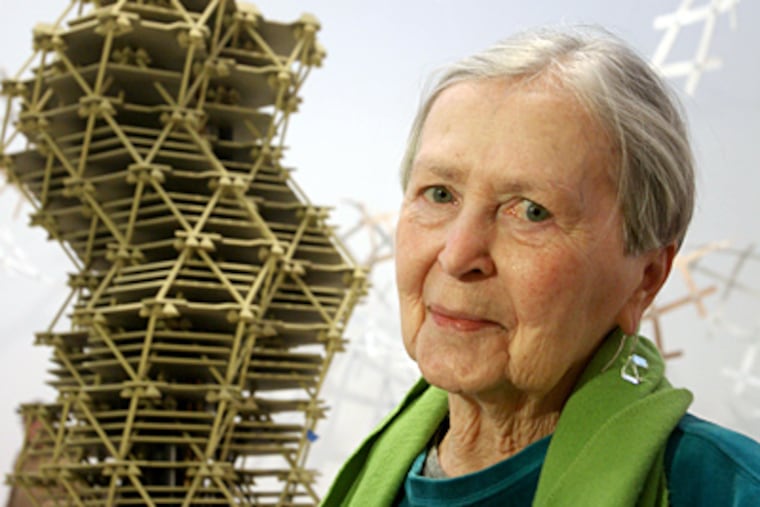Anne Tyng, 91, groundbreaking architect
Anne Tyng, a pioneering woman architect whose ideas about geometry influenced Louis Kahn's buildings and who later had a child with him, died Tuesday, Dec. 27, in Greenbrae, Calif. She was 91, said her daughter, Alexandra, who lives outside Philadelphia.

Anne Tyng, a pioneering woman architect whose ideas about geometry influenced Louis Kahn's buildings and who later had a child with him, died Tuesday, Dec. 27, in Greenbrae, Calif. She was 91, said her daughter, Alexandra, who lives outside Philadelphia.
Although Ms. Tyng was among the first group of women to graduate from Harvard University's architecture school in 1944, she struggled her entire career to be taken seriously. Firms would not hire her because she was a woman.
During her licensing exam in 1949, one of the proctors turned his back on her and refused to administer the test. She was the only female architect in the United States to seek registration that year, she recalled in an interview with The Inquirer.
Ms. Tyng eventually landed a job in Kahn's Center City office. During a 15-year relationship that was both professional and romantic, she helped him produce his pathbreaking early buildings, including the Trenton Bathhouse and the Yale Art Gallery. Yet until recently, she received little credit for those iconic projects.
"She was a victim of her time, being female, being beautiful. That was a pretty hard legacy to carry," said Carter Wiseman, author of the biography Louis I. Kahn: Beyond Time and Style. "She was constantly swimming upstream."
Kahn was married when he became involved with Ms. Tyng. Her pregnancy in 1953 was considered so scandalous that Kahn sent her to Rome. Their difficult relationship is captured in a collection of letters that Ms. Tyng published in 1997. It included only letters she received from Kahn, because he destroyed the replies.
Ms. Tyng's background was nearly the opposite of Kahn's impoverished immigrant experience. She was descended from an elite Boston family, and a portrait of a 19th-century ancestor, Ann Tyng, hangs in Boston's Museum of Fine Arts. In the early 20th century, her parents went to China as missionaries, and Ms. Tyng was born in Lushan, Jiangxi province, in 1920.
Despite the obstacles Ms. Tyng faced as a woman in a male field, she was determined to forge a career in architecture. She made her way to Philadelphia in 1945 and was hired by Stonorov & Kahn, one of the city's most innovative architectural practices. When Kahn struck out on his own, she followed him.
At the time, Kahn's designs adhered to strict modernist tenets about form and function. Ms. Tyng, who was fascinated by complex shapes called Platonic solids, pressed Kahn to incorporate those geometric shapes into the firm's work.
Her influence first became visible in the design of the Trenton Bathhouse, which proved to be Kahn's breakthrough. The deceptively simple arrangement of five cubes is still a fixture of architectural curriculums. In My Architect, a documentary by Kahn's third child, Nathaniel, Ms. Tyng was shown walking forlornly through the crumbling building. It was renovated in 2009.
Ms. Tyng is also responsible for the triangular ceiling grid at the Yale Art Gallery, based on one of her favorite geometric forms, the tetrahedron. Not only did the triangular openings transform the rectilinear galleries into a dynamic space, but they also provided an accessible cove for the electrical wires and heating ducts. Though common today, it was the first time the approach was used.
"Anne was as relentless in her insistence that geometry would solve problems of the world," said Wiseman. But for Kahn, geometry was merely the basis for creating timeless forms.
The first years of Ms. Tyng's collaboration with Kahn were "an incredibly powerful moment, when ideas were going back and forth," according to William Whitaker, a historian and the curator of the University of Pennsylvania's Architectural Archives.
But, as Alexandra Tyng observed, her parents "were not completely on the same wavelength." She said "their paths crossed for a brief period, then diverged." After their falling-out in 1964, Ms. Tyng left Kahn's office. She spent many years teaching architecture at Penn.
Ms. Tyng spent most of her adult life in a Fitler Square rowhouse. Although it appeared ordinary on the outside, she rebuilt the interior to express her ideas about geometry, and it was perhaps her most personal design.
In recent years, she grew more vocal about the lack of credit she received for her work in Kahn's office. But she also began to receive more recognition. In 2010, the Institute of Contemporary Art organized the first retrospective of her work. In October, she was invited back to Harvard's architecture schools - as a keynote speaker.
In addition to her daughter, Ms. Tyng is survived by two grandchildren and two brothers.
A memorial service is being planned.